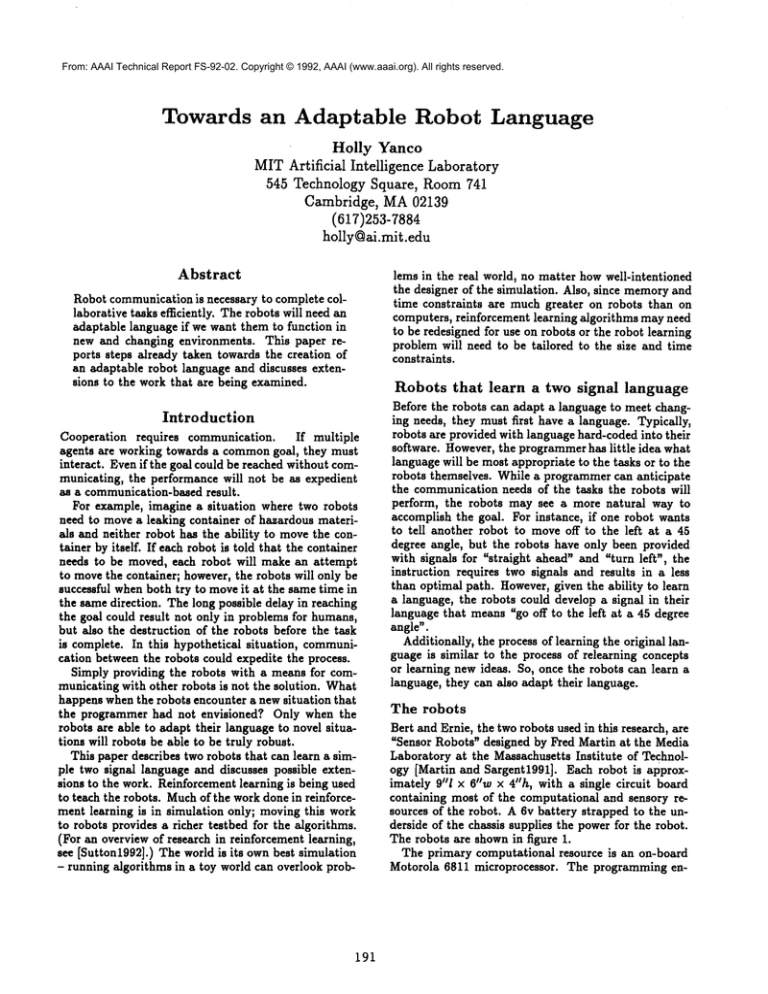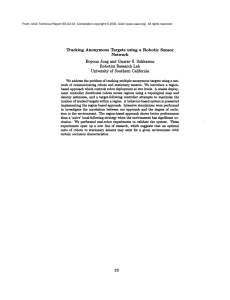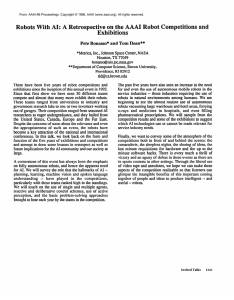
From: AAAI Technical Report FS-92-02. Copyright © 1992, AAAI (www.aaai.org). All rights reserved.
Towards an Adaptable
Robot Language
Holly Yanco
MITArtificial Intelligence Laboratory
545 Technology Square, Room741
Cambridge, MA02139
(617)253-788
holly@ai.mit.edu
Abstract
lems in the real world, no matter how well-intentioned
the designer of the simulation. Also, since memoryand
time constraints are much greater on robots than on
computers, reinforcement learning algorithms may need
to be redesigned for use on robots or the robot learning
problem will need to be tailored to the size and time
constraints.
Robot communication is necessary to complete collaborative tasks efficiently. The robots will need an
adaptable language if we want them to function in
new and changing environments. This paper reports steps already taken towards the creation of
an adaptable robot language and discusses extensions to the work that are being examined.
Robots that
Introduction
Cooperation requires communication. If multiple
agents are working towards a commongoal, they must
interact. Even if the goal could be reached without communicating, the performance will not be as expedient
as a communication-based result.
For example, imagine a situation where two robots
need to movea leaking container of hazardous materials and neither robot has the ability to movethe container by itself. If each robot is told that the container
needs to be moved, each robot will make an attempt
to movethe container; however, the robots will only be
successful when both try to moveit at the same time in
the same direction. The long possible delay in reaching
the goal could result not only in problems for humans,
but also the destruction of the robots before the task
is complete. In this hypothetical situation, communication between the robots could expedite the process.
Simply providing the robots with a means for communicating with other robots is not the solution. What
happens when the robots encounter a new situation that
the programmer had not envisioned? Only when the
robots are able to adapt their language to novel situations will robots be able to be truly robust.
This paper describes two robots that can learn a simple two signal language and discusses possible extensions to the work. Reinforcement learning is being used
to teach the robots. Muchof the work done in reinforcement learning is in simulation only; moving this work
to robots provides a richer testbed for the algorithms.
(For an overview of research in reinforcement learning,
see [Sutton1992].) The world is its own best simulation
- running algorithms in a toy world can overlook prob-
191
learn
a two signal
language
Before the robots can adapt a language to meet changing needs, they must first have a language. Typically,
robots are provided with language hard-coded into their
software. However, the programmerhas little idea what
language will be most appropriate to the tasks or to the
robots themselves. While a programmer can anticipate
the communication needs of the tasks the robots will
perform, the robots may see a more natural way to
accomplish the goal. For instance, if one robot wants
to tell another robot to moveoff to the left at a 45
degree angle, but the robots have only been provided
with signals for "straight ahead" and "turn left", the
instruction requires two signals and results in a less
than optimal path. However, given the ability to learn
a language, the robots could develop a signal in their
language that means "go off to the left at a 45 degree
angle".
Additionally, the process of learning the original language is similar to the process of relearning concepts
or learning new ideas. So, once the robots can learn a
language, they can also adapt their language.
The robots
Bert and Ernie, the two robots used in this research, are
"Sensor Robots" designed by Fred Martin at the Media
Laboratory at the Massachusetts Institute of Technology [Martin and Sargent1991]. Each robot is approximately 9"1 × 6"w × 4"h, with a single circuit board
containing most of the computational and sensory resources of the robot. A 6v battery strapped to the underside of the chassis supplies the power for the robot.
The robots are shown in figure 1.
The primary computational resource is an on-board
Motorola 6811 microprocessor. The programming en-
From: AAAI Technical Report FS-92-02. Copyright © 1992, AAAI (www.aaai.org). All rights reserved.
Figure 1: Ernie and Bert
vironment is IC, a41 multi-tasking interactive C compiler and interpreter
developed by Randy Sargent
[Sargent and Martin1991]. Ic allows the sensor robot to
be addressed through a serial line from a host computer
as well as the downloading of programs for autonomous
activity. The work described in this paper was implemented with the robots under autonomous control.
Locomotionis controlled by a dual geared-wheel drive
stripped from a Radio Shack Red Fox Racer. The direction of the robot is controlled by varying the speed
of both the left and right motors (with negative speed
moving the motor backwards). The two motorized
wheels
areat therearof therobotchassis
anda caster
ison thefront.
Communication
from humanto Bert is throughan
infra-red
remotecontroltransmitter.
Bertreceives
theinfra-red
signals
using
infra-red
receivers
similar
to
thosefoundin televisions
andVCRs.WhileErniealso
has infra-red
receivers
on board,theyare notbeing
usedin thiswork- onlyBerthearssignalsfromhumane.Robotscommunicate
betweenthemselves
using
a pairof radio transmitter
andreceiver boardssimilar
to thoseusedin garagedooropeners.
Therobotsare
ableto sendandreceive
four-bit
packets
throughthe
boards.(Thetransmitter
andreceiver
eachrunoffof
a separate
9v battery.)
In addition,
eachrobothas
speakerand a 16-character
LCD,bothusedprimarily
fordebugging
andmonitoring
of therobot’s
activity.
In addition
to theinfra-red
andradioreceivers,
the
sensorrobotscontainfour(frontandrear,leftand
right)bumpsensors,
leftandrightshaftencoders,
an
inclination
sensor,
photosensitive
cells,
a microphone,
192
and infra-red emitters. The additional sensory abilities
of the robots were not substantively used in the experiments described here.
Description
of initial
work
In [Yanco and Stein1992], we report work in which Bert
and Ernie develop a simple two signal language. The
robots are given the task of coordinated movement(either both spin or both go straight). So that communication is required between the robots, only Bert receives
the task signal from the outside world.
Uponreceiving a signal, Bert has to choose an action
to perform (either 8pin or straight) and a signal to send
to Ernie (either high or low). WhenErnie hears a signal
from Bert, he must select an action to perform (again,
either spin or straight). Initially, the robots select actions randomly.
The robots learn the task using a reinforcement
learning algorithm. Currently, the interval estimation
method [Kaelbling1990] is being employed. Tallies are
kept of the numberof times a particular action has been
performed on an input and the number of times that
positive reinforcement has been received. An optimization function is used to select the next action to be performed on a given input. The robots only receive good
reinforcement (+) whenthe task is performed correctly.
If the robots have been told to both spin but only one
spins, the robots receive negative reinforcement (-).
(Understanding of reinforcement signals is hard-coded
into the robots.) This task based reinforcement is discussed in [Yanco and Stein1992].
H
From: AAAI Technical Report FS-92-02.
Copyright © 1992, AAAI
(www.aaai.org).
All rightsI[
reserved.
Appropriate
Leader’s
F°ll°wer’s
Reinf°rcementaction
1.
2.
,
.
.
.
.
g.
.
10.
11.
12.
13.
action
TT
O0
TT
O0
O0
TT
O0
O0
O0
1"1"
TT
O0
action [ signal
spin
low
spin
lOW
straight
high
straight
high
spin
lOW
straight
high
spin
low
spin
low
spin
Jow
spin
low
straight
high
straight
high
spin
lOW
spin
straight
spin
straight
spin
spin
spin
spin
spin
spin
straight
straight
spin
+
+
+
+
+
+
+
Figure 2: A sample run. The desired behavior is both spin on input 00, both go straight on input
iterations, convergence is reached.
The robots learn the task and a private robot
language after five to fifteen instruction-actionreinforcement cycles. A sample run is shownin figure 2.
Already we have developed an adaptable language.
Once the robots have converged upon a robot language,
they are able to relearn what the signals mean. For example, if we change the input that originally meant both
spin to Bert spin and Ernie go straight, the robots can
relearn the task. While this new training is going on,
Bert maydecide to send Ernie the signal that they have
already agreed upon as straight or the robots may reassign the meaning straight to the signal that Ernie used
to interpret as spin. The relearning process generally
takes a number of steps equal to the number of training runs (since negative reinforcement must be received
enough times to make the robots want to try a new behavior rather than sticking with the behavior that used
to provide positive reinforcement).
Looking forward
There are many possible extensions to the work described above. Twoextensions are discussed below.
Compositional
language
The space of possible actions and signals in the initial
work was intentionally kept very small. In the reinforcement algorithm, two variables must be kept for
each possible action on each possible input. Thus, the
required variables grow exponentially with each additional action added. In a simulation, memoryand time
may not matter; however, this is a real issue for autonomous robots with limited memorythat we want to
act in real-time.
Our current goal is to have the robots develop a compositional language. In a compositional language, there
193
TT.After thirteen
are words and relationships between words. For example, the robots may learn a word for "go straight" and
modifiers such as "quickly" and "slowly". The advantage of a compositional language is that the robots need
only learn each concept once, rather than relearn it every time it reappears in a new sentence. This is similar
to English; we understand words and how they fit together and need not relearn everything when presented
with a new sentence.
The reuse of concepts on robots will save both learning time and memory. If the robots had to build a
reinforcement table for each new sentence, they would
soon run out of memory. However, if the robots learn
the words separately first, muchless memoryis required
to learn composed sentences. Also, the amount of time
necessary to learn the composed utterance should be
much smaller than the the time required to learn the
meaning of the whole utterance without any clues to
the meaning of the parts.
Autonomous
reinforcement
Once the robots have developed a compositional language, they will be able to explore the world and talk
to one another. If they encounter a new situation, they
will either need to compose a new sentence or learn a
new concept. At this time, all reinforcement is provided
by a humansignal; however, for the robots to be truly
autonomous, they would need to reinforce one another’s
behaviors. For instance, if Bert wanted Ernie to help
him move an object, Bert would send Ernie a signal
that he means to be "help move object". If Ernie goes
off and continues to explore the world, Bert should send
Ernie negative reinforcement.
Thr robots would need to have additional capabilities to be able to reinforce one another. Most importantly, they would need to have an understanding that
From: AAAI
Technical
Report
Copyright
© 1992,
All rights reserved.
there
are other
robots
inFS-92-02.
the world
that they
areAAAI
able(www.aaai.org).
[Shewchuk1991]
John P. Shewchuk. Ph.D. thesis proto influence. This understanding could come through
posal, 1991.
a vision system that recognizes other robots and the
[Sutton1992] Richard S. Sutton. Special issue on reinactions the other robots are performing. It could also
forcement learning. Machine Learning, 8(3-4), May
come through an action echoing system provided to the
1992.
robots in software. For example, if Ernie went straight,
[Yanco and Stein1992] Holly Yanco and Lynn Andrea
he would broadcast the signal "I went straight". This
Stein. An adaptive communication protocol for cois a simpler method of getting the robots to reinforce
operating mobile robots. MIT AI Memo1379, MIT
one another since adding vision to the robots would be
Artificai Intelligence Lab, August 1992. Submitted
no small task.
to SAB-92.
To reinforce one another, the robots could continue
to use the built in understanding of reinforcement signals. Alternatively, the robots could make changes to
the world to reinforce other robots. For example, suppose Bert wanted Ernle to turn right, but Ernie went
straight instead. Bert could then move an obstacle in
front of Ernie that could make Ernie turn right.
Self-reinforcement is necessary if we want the robots
to act autonomouslyin novel situtations. In space, human reinforcement could not arrive quickly enough from
Earth to allow the robots to react to changing situations
in a reasonable amountof time. Also, self-reinforcement
would be useful in situations that are hazardous to
humans. If human-to--robot communication were destroyed for some reason, the robots would be able to
carry on with their tasks by reinforcing one another.
Acknowledgements
The initial work has been directly inspired by work done
by John Shewchuk [Shewchuk1991]. Portions of the
research described here were done jointly with Lynn
Stein, who has provided immeasurable guidance. I’d
also like to thank CandySidner, Rod Brooks, Fred Martin, Ian Horswill and Jeanne Speckman.
The author is supported in part by a scholarship from
the Digital Equipment Corporation. Support for this
research was also provided by the Gordon S. Brown
Fund of the Department of Electrical Engineering and
Computer Science at MIT. This report describes research done at the Artificial Intelligence Laboratory
of the Massachusetts Institute of Technology. Support for the laboratory’s artificial intelligence research
is provided in part by the Advanced Research Projects
Agency of the Department of Defense under Office of
Naval Research contract N00O14-85-K-0124.
References
[Ka~lbling1990] Leslie Pack Kaelbling. Learning in embedded systems. Technical Report TR-90-04, Teleos
Research, June 1990.
[Martin and Sargent1991] Fred Martin and Randy Sargent. The mit sensor robot: User’s guide and technical reference, October 1991.
[Sargent and Martin1991] Randy Sargent and Fred
Martin. IC: Multi-tasking interactive C for the 6811.
IC Version 2.5, October 1991.
194




